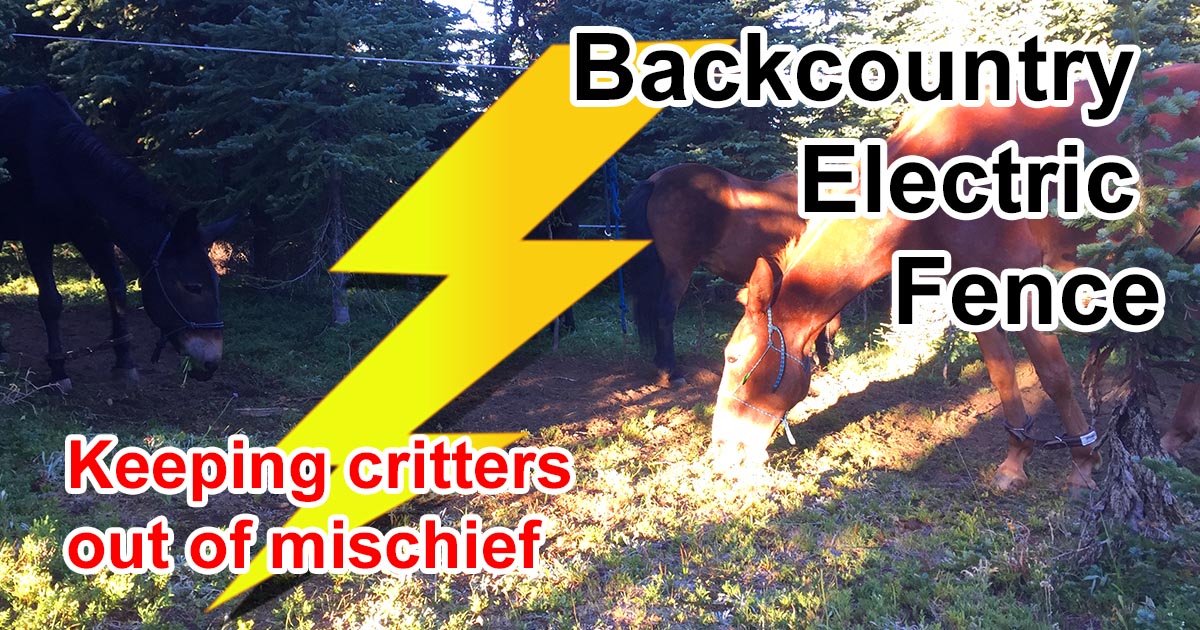Backcountry Electric Fence
Recently I had the opportunity to pack into Oregon’s Eagle Cap Wilderness with a team of USFS packers. Working with them gave me many ideas to try on my recreational pack trips. One of the tools that these professional packers used was an electric fence system that allowed their animals to graze and relax in a high mountain meadow.
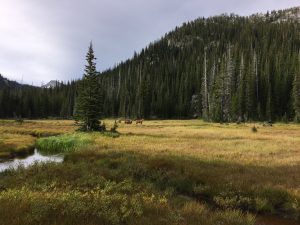 Electric fencing in the backcountry can provide a portable and cost-effective barrier that can give you nearly the same security, convenience and reliability as at home.
Electric fencing in the backcountry can provide a portable and cost-effective barrier that can give you nearly the same security, convenience and reliability as at home.
Prior to my electric fence experiment I spent several hours of each day monitoring the grazing of my animals. And by monitoring I mean hobbling then watching with an eagle eye while they ate and wandered, bringing them closer when warranted, and collecting them up when the grass over yonder became more tempting than what was under their noses. Failure to do so invariably meant a long walk to fetch my wandering herd. Now I can relax by the camp stove with a cup of coffee while my mules relax, roll, and eat.
Electric fences are a psychological barrier that keeps our animals in and wild animals out. When a critter touches an electrified wire the electricity passes through the animal, into the soil, to the ground rod and back to the energizer. The electrical circuit is then completed and the animal receives a harmless “correction” (a noticeably unpleasant shock) and becomes trained to stay clear of the fence.
Going electric took a few missteps before we settled on a solution that worked for us. Here’s a backcountry electric fence system that works for us.
Parts of a Backcountry Electric Fence:
Charger
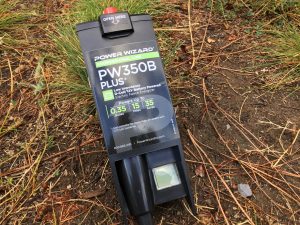 The fence energizer is the heart of the system and a piece that I got wrong at first. In my quest for lightweight solutions I went with a 2 D-cell unit that sends out .04 joules of energy. While it worked fine at home it wasn’t nearly powerful enough in the less than perfect conditions you’ll find at a campsite.
The fence energizer is the heart of the system and a piece that I got wrong at first. In my quest for lightweight solutions I went with a 2 D-cell unit that sends out .04 joules of energy. While it worked fine at home it wasn’t nearly powerful enough in the less than perfect conditions you’ll find at a campsite.
The new charger puts out eight times the power (.35 joules), uses just 4 D-cells, and is also featured in commercial bear fences that keep grizzlies out of trouble. If it can keep a bruin out of camp surely it can keep a few mules in. My thinking is that I want to knock the socks off any critter that even considers breaching the fence. Go with the most powerful energizer you can, remembering that you’ll rarely encounter perfect conditions when camping.
- The charger we use – Power Wizard PW350B+ – https://amzn.to/2RKfaur
Electric Tape
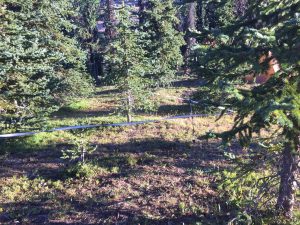 – You have a myriad of options on how to transmit your electric charge. The two most common are wire or tape. We started with 9-strand wire because it rolls up into a small package allowing me to carry more in a smaller space. That compact size turned out to be problematic as it wasn’t very visible. I ended up having to hang flagging tape on the wire. 1/2 inch wide tape takes up a bit more room but it’s highly visible to everyone.
– You have a myriad of options on how to transmit your electric charge. The two most common are wire or tape. We started with 9-strand wire because it rolls up into a small package allowing me to carry more in a smaller space. That compact size turned out to be problematic as it wasn’t very visible. I ended up having to hang flagging tape on the wire. 1/2 inch wide tape takes up a bit more room but it’s highly visible to everyone.
- Wire we used – https://amzn.to/2FYL1ow
- Tape we use – https://amzn.to/3kDpDVb
How much tape to use depends on how big of an enclosure you want to make. The USFS packers fenced in several acres. I don’t need nearly that much space and only haul 350 feet of tape. That gives me a corral of about 8 thousand square feet that easily goes around my highline area. I still take my animals out to graze beyond the enclosure but I do this when it’s more convenient for me.
Posts
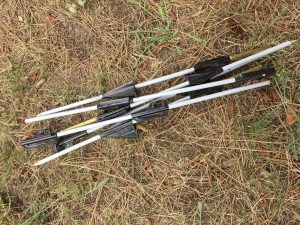 – You need to hang the tape on something and in the absence of trees a few posts come in handy. I took fiberglass posts, cut them down, and added a ferrule with epoxy so that they could break down and fit easily in a pack box.
– You need to hang the tape on something and in the absence of trees a few posts come in handy. I took fiberglass posts, cut them down, and added a ferrule with epoxy so that they could break down and fit easily in a pack box.
- What I used – https://amzn.to/3kEORm9
- What I would do now – https://amzn.to/35UouVc bright color with reflective tape – I don’t need clips
When you’re in camp you can also use nearby trees as posts with insulators of bungee cords or even baling twine. Using nearby trees lets you considerably extend the size of fence.
Ground
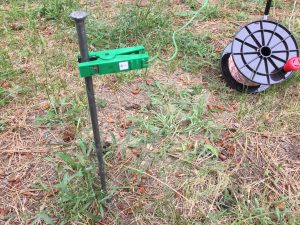 – The biggest reason for electric fence failures is improper grounding. The electricity must complete a full circle back to the charger through the ground. The output pulse travels down the fence wire into the horse touching the wire then into the soil under the horse’s hooves. And then through the soil back to the ground system, which completes the circuit. Poor grounding gives weak shocks.
– The biggest reason for electric fence failures is improper grounding. The electricity must complete a full circle back to the charger through the ground. The output pulse travels down the fence wire into the horse touching the wire then into the soil under the horse’s hooves. And then through the soil back to the ground system, which completes the circuit. Poor grounding gives weak shocks.
A lot of grounding depends on the surface the fence is set up on. Dry ground as well as sand and gravel are poor conductors, substantially reducing the shock delivered by the fence. Electric fences work best on moist ground, or if the fence is designed so that the animal touches both a ground wire and a hot wire at the same time.
- For my ground rod I used a piece of galvanized steel that I had in the barn
- What I would do now – https://amzn.to/32Nhtn6 and cut it down
Miscellaneous bits and bobs:
- Gate Handle– What we used – https://amzn.to/33HO4df
- Reel – Keeps your tape tidy – https://amzn.to/2ZVYWTw
- Fence Tester – Tells how much current is flowing – https://amzn.to/2ZTl3u0
Using an Electric Fence in the Backcountry
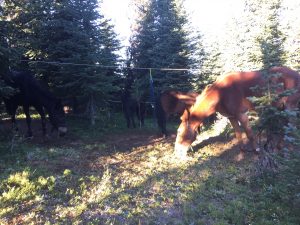 When I’m in a backcountry camp I alternate between highlining, hobbling and pasturing within the electric fenced area. I set up the electric fence around the highline. At night or if I leave camp without them, all of my animals are on the highline. When I’m around camp I’ll let the ponies off the highline, hobble them, and let them graze and relax in their back country paddock while I cook or tinker about. Since my setup is relatively small I still take the mules out of their paddock to graze while hobbled under my watchful eye.
When I’m in a backcountry camp I alternate between highlining, hobbling and pasturing within the electric fenced area. I set up the electric fence around the highline. At night or if I leave camp without them, all of my animals are on the highline. When I’m around camp I’ll let the ponies off the highline, hobble them, and let them graze and relax in their back country paddock while I cook or tinker about. Since my setup is relatively small I still take the mules out of their paddock to graze while hobbled under my watchful eye.
For more information on trail riding and camping with horses as well as the world’s largest guide to horse trails and camps visit us at www.TrailMeister.com.


